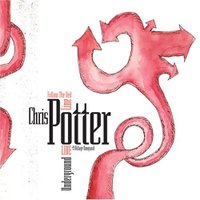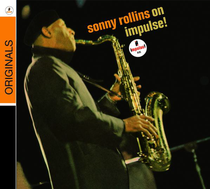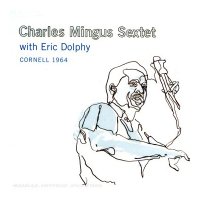 One for Newcomers: Are you one of those people who listens
mainly to rock and pop or rap and hiphop, but has long had a nagging
feeling that maybe you should have more jazz in your music collection
than just "Kind of Blue" and that Albert Ayler record you
got in college but never listen to? If you are, here's one you might love: The Chris
Potter Underground's Follow the Red Line—Live at the Village Vanguard
One for Newcomers: Are you one of those people who listens
mainly to rock and pop or rap and hiphop, but has long had a nagging
feeling that maybe you should have more jazz in your music collection
than just "Kind of Blue" and that Albert Ayler record you
got in college but never listen to? If you are, here's one you might love: The Chris
Potter Underground's Follow the Red Line—Live at the Village Vanguard. It's a rollicking, rousing live performance (live is usually better
with jazz) that will have you at least tapping your foot, if not jumping and juking to the rhythm. This is a fun album—accessible, propulsive—that
doesn't dumb down the music, despite Adam Rogers' rock-y guitar on "Pop Tune
#1." The extended timings might take a little concentration, and
"Arjuna" could put you in mind of Mahavishnu-Orchestra-era John
McLaughlin, but with Potter's driving sax lines and Nate Smith's crisp, cracking drums,
this is robust, high-voltage contemporary jazz without a hint of the
"smooth" infection. The sound quality is well above average, immediate
and clean.
 One for Audiophiles: There's something about Sonny Rollins'
raw, rasping, guttural sax sound that makes it sound like a living,
breathing animal—and that also gives it a striking vividness that can
put it right into your living room. After establishing himself on RCA,
Rollins went over to Impulse—his friend John Coltrane's label—and
recorded three albums there over the course of one year (1965-'66). The
first was On Impulse
One for Audiophiles: There's something about Sonny Rollins'
raw, rasping, guttural sax sound that makes it sound like a living,
breathing animal—and that also gives it a striking vividness that can
put it right into your living room. After establishing himself on RCA,
Rollins went over to Impulse—his friend John Coltrane's label—and
recorded three albums there over the course of one year (1965-'66). The
first was On Impulse, a fine quartet outing with Ray Bryant on piano, Mickey Roker
on drums, and Walter Booker on bass, who puts in a fine solo on
"Everything Happens to Me." (I believe the other two Rollins titles on Impulse were the movie soundtrack
Alfie! and East Broadway Run Down). (Note that there's also a new compilation album drawn from all three albums that has the same cover art—it's called "The Impulse Story"—and it's not really recommended, as these three albums are not especially interchangeable.) The time period was also a high
point for purist recording techniques, which was great good fortune for
posterity. The new "Originals" remastering of On Impulse (Verve00602517448216)
exhibits the overemphasized stereo spread characteristic of the
era—piano right, drums left, sax dead center—but that doesn't detract
from the music at all. Otherwise, the sound quality is wonderful, as
only a great recording of a small acoustic ensemble can be, with great
balance, startling vividness, and the kind of clarity that lets you
concentrate on individual lines or the interplay between instruments on
successive listenings. The timing is less that 34 minutes, and the CD
is full price for five tracks, but in this case you shouldn't let that worry you. The music is worth it. It's one of the high points of the entire Sonny Rollins discography, and the sound quality is something to be relished.
 One for Jazz Fanatics: Saved for last with good reason is a tremendous historical document of the highest importance and musical enjoyment. What is Cornell 1964
One for Jazz Fanatics: Saved for last with good reason is a tremendous historical document of the highest importance and musical enjoyment. What is Cornell 1964? As Andrew Bartlett writes, "The band that Charles Mingus, the doyen of jazz's mercurial polymaths,
pulled together for his early-1964 European tour was phenomenal—and
here they are playing 130 minutes worth of live music no one’s ever
heard." The doomed Eric Dolphy (he died soon thereafter, of untreated diabetes) is featured, but everybody's playing was on that night. It was apparently never considered for release—the tour was new and the band were off to Europe. Mingus's widow, Sue, recently found the tapes. Wow.
You can tell something special is happening right from Jaki Bayard's opening piano vamp, with its laughing barrelhouse phases. After an interlude of applause, in comes Mingus, playing, weaving, by turns stonefaced and jokey. At first the band is too loose, playful, unserious, but you can just hear it turn into one of those live dates where the stars align and everything goes right. By the time the band gets to the centerpiece, the half-hour-long "Meditations on Integration," they're in full flight. There are five cuts here longer than 15 minutes, and the sound quality is adequate. Non-jazz fans probably won't care for this one (although for non-Mingus fans it could be a very cool place to start). But if you're into jazz it's just rare treasure, that's all. It's great to know there's still stuff like this out there, waiting to be found.
________________
Copyright 2007 by Michael C. Johnston—All Rights Reserved
______________
Support this site
Do you enjoy The Online Photographer? Any time you visit one of the following sites using the links below as a portal, we get a small commission for everything in any product category you might purchase during your visit, no matter how long you stay on their sites or how many pages you visit (and the prices are always the same to you either way). It's a nice and easy way to help enable T.O.P. to prosper while making your online purchases.



